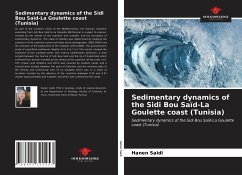As part of the southern shore of the Mediterranean, the Tunisian coastline extending from Sidi Bou Saïd to La Goulette (NE-Tunisia) is subject to erosion marked by the retreat of the coastline and isobaths and the disruption of sedimentary dynamics. The state of stability was determined by studying the evolution of the coastline using multi-date aerial photographs (1962-2000) and the evolution of the bathymetry of the shallows (1974-2000). The granulometric study of superficial sediments (depths from 0 to 7 m). The results showed the existence of two unstable zones with inverse sedimentary dynamics: a zone located between the marina of Sidi Bou Saïd and the tip of Salammbô which suffered from erosion marked by the retreat of the coastline (of the order of 0. 075 m/year) and isobaths and which was covered by medium sands and a second zone located between the point of Salambo and the northern jetty of the fishing and commercial port of La Goulette which was in a state of accretion marked by the advance of the coastline (between 0.25 and 0.47 m/year approximately) and isobaths and which was covered by fine sands.








